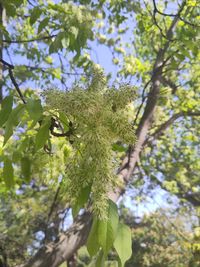Issued on April 25, 2025
The weather influences the pollen count!
Weather situation. The periods of rain forecast for the coming days will bring temporary relief for pollen allergy sufferers. However, as soon as the sun returns, a renewed increase in allergenic load is to be expected.
Birch pollen. We are currently seeing moderate concentrations of birch pollen in the Tyrolean valleys. At higher altitudes above 1500 m, the pollen load remains low. Our data indicates that the peak of the birch pollen season has already passed in the lower valleys - we now expect low to moderate concentrations there. At medium to higher altitudes, however, the birch trees are still in bloom, which is why an increase in pollen levels can be expected locally despite the overall low values. In addition, low to moderate amounts of hornbeam and hop hornbeam pollen are measured, which are frequently found in parks and gardens. Due to their cross-reactivity with birch pollen, these species can trigger allergic reactions in sensitized people and thus intensify the symptoms. Oak pollen is also on the increase and can reach medium concentrations. Like hornbeam and hop hornbeam, they can also cause cross-reactions in birch allergy sufferers.
Ash pollen. A low to moderate allergenic load of ash p ollen continues to be recorded in the region.
Sycamore pollen. Concentrations of plane tree pollen can reach moderate levels, especially along avenues and streets with plane tree planting.
Grass pollen. The first grass pollen has been detected in the air in Tyrol. The concentrations are currently still low, but an increase is expected at the beginning of May. We will keep you up to date on developments.
Other types of pollen. Pollen from pine, spruce, larch, walnut, cypress and willow has also been detected. However, these are of minor allergological significance.
Stay informed and take precautions. To combat allergies effectively, it is crucial to be informed about the current pollen situation in your region. Pay attention to our updates and remember to take appropriate precautions to minimize discomfort and enjoy your time outdoors as much as possible.
Responsible for the content
Universität Innsbruck
Institut für Botanik
Dr. Laurent Marquer
Mittelfristige Prognose basierend auf Modelldaten und Pollenzählungen.
Auszugweiser oder vollständiger Nachdruck und Veröffentlichung nur unter Angabe der Quelle gestattet.
Wetterdaten und Prognosen basierend auf synoptischen Daten:
GeoSphere Austria, Bundesanstalt für Geologie, Geophysik, Klimatologie und Meteorologie (ehemals ZAMG).
zum Team


